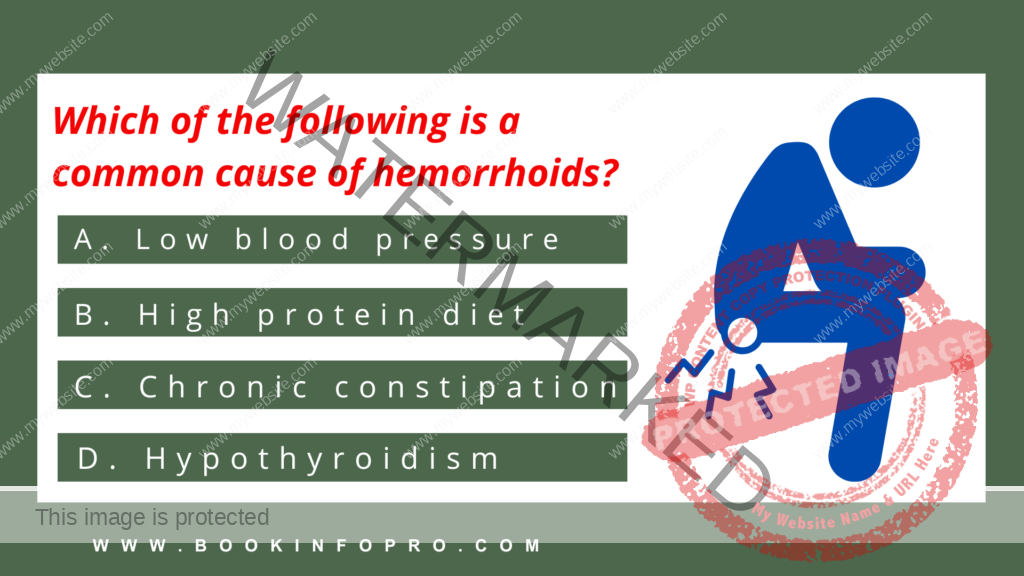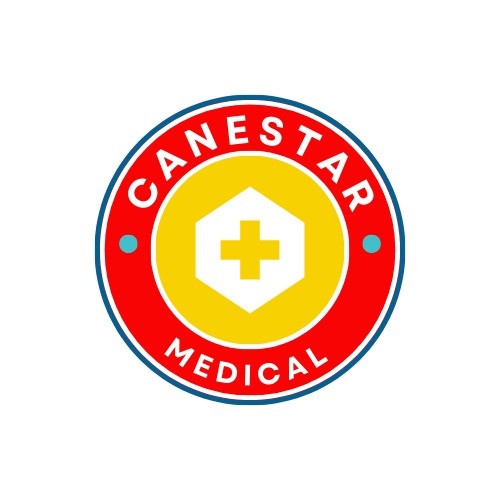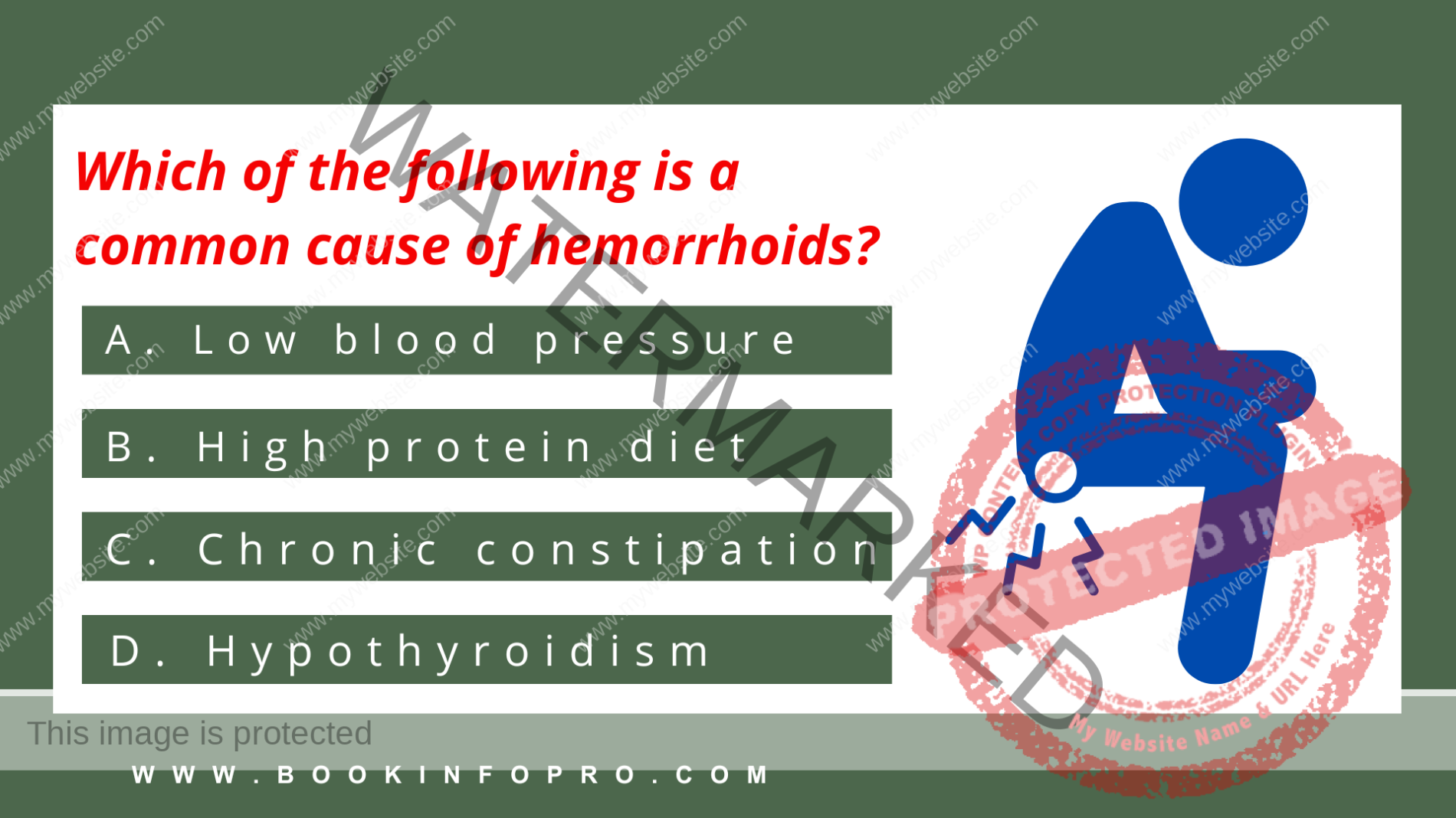Hemorrhoids MCQ and Quiz for Exam Preparation
1. What are hemorrhoids?
A. Swollen lymph nodes
B. Varicosities of the rectal veins
C. Infected anal glands
D. Inflammation of the appendix
✅ Answer: B
Rationale: Hemorrhoids are dilated and swollen veins in the rectum or anus.
2. Which of the following is a common cause of hemorrhoids?
A. Low blood pressure
B. High protein diet
C. Chronic constipation
D. Hypothyroidism
✅ Answer: C
Rationale: Straining during bowel movements due to constipation increases pressure in rectal veins.
3. Internal hemorrhoids originate from which venous plexus?
A. Inferior mesenteric vein
B. External hemorrhoidal plexus
C. Internal hemorrhoidal plexus
D. Portal vein
✅ Answer: C
Rationale: Internal hemorrhoids arise above the dentate line from the internal plexus.
4. Which symptom is most characteristic of external hemorrhoids?
A. Painless bleeding
B. Itching
C. Protrusion with defecation
D. Painful swelling at the anus
✅ Answer: D
Rationale: External hemorrhoids are covered by sensitive skin, causing pain when thrombosed.
5. Hemorrhoids that prolapse and require manual reduction are classified as:
A. Grade I
B. Grade II
C. Grade III
D. Grade IV
✅ Answer: C
Rationale: Grade III hemorrhoids prolapse and require manual repositioning.
6. Which of the following diagnostic procedures is commonly used to examine internal hemorrhoids?
A. Colonoscopy
B. Anoscopy
C. MRI
D. Endoscopy
✅ Answer: B
Rationale: Anoscopy allows direct visualization of the anal canal and internal hemorrhoids.
7. A thrombosed external hemorrhoid is best treated with:
A. Stool softeners
B. Surgical excision
C. Sclerotherapy
D. Cryotherapy
✅ Answer: B
Rationale: Surgical excision provides rapid relief from pain caused by thrombosis.
8. First-line treatment for uncomplicated internal hemorrhoids includes:
A. Hemorrhoidectomy
B. Radiation therapy
C. Lifestyle and dietary modifications
D. Corticosteroids
✅ Answer: C
Rationale: Increasing fiber, fluids, and avoiding straining are key non-surgical treatments.
9. Rubber band ligation is used to treat:
A. External hemorrhoids
B. Internal hemorrhoids
C. Fistulas
D. Rectal cancer
✅ Answer: B
Rationale: Rubber band ligation is effective for Grade I-III internal hemorrhoids.
10. Which of the following is NOT a typical symptom of hemorrhoids?
A. Bright red rectal bleeding
B. Mucus discharge
C. Anal pain
D. Black tarry stools
✅ Answer: D
Rationale: Black tarry stools suggest upper GI bleeding, not hemorrhoids.
11. What does the presence of bright red blood on toilet paper typically indicate?
A. Hemorrhoids
B. Gastritis
C. Peptic ulcer
D. Diverticulitis
✅ Answer: A
Rationale: Bright red blood usually comes from the distal rectum or anal canal, as in hemorrhoids.
12. Which position relieves pressure on rectal veins during pregnancy?
A. Supine
B. Trendelenburg
C. Left lateral
D. Prone
✅ Answer: C
Rationale: Left lateral positioning improves venous return and reduces rectal vein pressure.
13. Which complication is associated with hemorrhoids?
A. Appendicitis
B. Strangulated prolapse
C. Hepatic encephalopathy
D. Ureteral obstruction
✅ Answer: B
Rationale: Prolapsed hemorrhoids can become strangulated and necrotic if untreated.
14. What is the role of flavonoids in hemorrhoid treatment?
A. Reduce bleeding time
B. Increase platelet count
C. Strengthen venous tone and reduce inflammation
D. Act as antibiotics
✅ Answer: C
Rationale: Flavonoids improve venous tone and capillary resistance, relieving symptoms.
15. Sitz baths help relieve symptoms of hemorrhoids by:
A. Drying the area
B. Increasing blood pressure
C. Reducing inflammation and pain
D. Causing vasoconstriction
✅ Answer: C
Rationale: Warm water improves circulation and soothes inflamed tissues.
16. Which of the following is an indication for hemorrhoidectomy?
A. Grade I hemorrhoids
B. External hemorrhoids without complications
C. Failed conservative therapy for Grade III-IV
D. Mild intermittent bleeding
✅ Answer: C
Rationale: Surgical removal is for severe, persistent, or complicated hemorrhoids.
17. Which anesthetic is often used in topical hemorrhoid preparations?
A. Lidocaine
B. Morphine
C. Fentanyl
D. Diazepam
✅ Answer: A
Rationale: Lidocaine is a local anesthetic commonly included in hemorrhoid creams.
18. A common over-the-counter treatment for hemorrhoids is:
A. Omeprazole
B. Hydrocortisone cream
C. Amoxicillin
D. Simethicone
✅ Answer: B
Rationale: Hydrocortisone reduces inflammation and itching in hemorrhoid creams.
19. Which of the following should be avoided in a patient with hemorrhoids?
A. High-fiber diet
B. Drinking water
C. Prolonged sitting
D. Walking
✅ Answer: C
Rationale: Sitting for long periods increases rectal pressure and worsens hemorrhoids.
20. What is the function of stool softeners in hemorrhoid treatment?
A. Increase stool volume
B. Prevent infection
C. Reduce straining
D. Stimulate peristalsis
✅ Answer: C
Rationale: Stool softeners reduce the need to strain during bowel movements.
21. Which vitamin deficiency is most likely to worsen bleeding hemorrhoids?
A. Vitamin A
B. Vitamin C
C. Vitamin K
D. Vitamin D
✅ Answer: C
Rationale: Vitamin K is essential for clotting; deficiency increases bleeding tendency.
22. Hemorrhoid bleeding is usually described as:
A. Occult and intermittent
B. Black and tarry
C. Bright red and painless
D. Coffee ground appearance
✅ Answer: C
Rationale: Bright red, painless rectal bleeding is a hallmark of internal hemorrhoids.
23. What is the main purpose of increasing fiber in hemorrhoid patients?
A. Cause diarrhea
B. Soften stools and reduce straining
C. Increase rectal pressure
D. Improve protein absorption
✅ Answer: B
Rationale: Fiber adds bulk and moisture to stool, preventing constipation.
24. Which is a known risk factor for hemorrhoids?
A. High HDL levels
B. Chronic coughing
C. Hypoglycemia
D. Asthma
✅ Answer: B
Rationale: Chronic coughing increases intra-abdominal pressure, affecting rectal veins.
25. The dentate line in the anal canal is important because:
A. It marks the end of the colon
B. It separates internal and external hemorrhoids
C. It controls continence
D. It secretes digestive enzymes
✅ Answer: B
Rationale: The dentate (pectinate) line anatomically distinguishes internal from external hemorrhoids.


